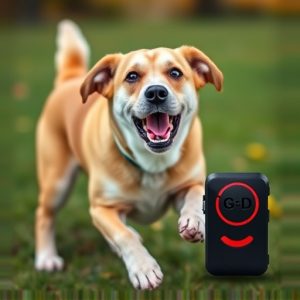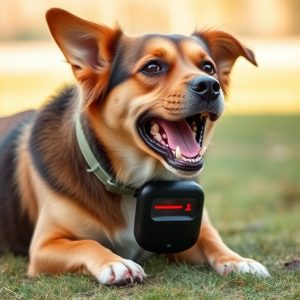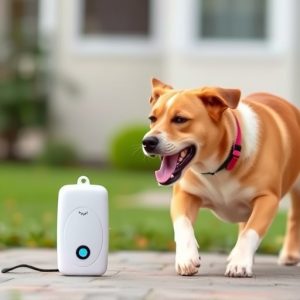Mastering Dog Control: Top Sonic Equipment and Vibrational Settings
Sonic equipment for dog control offers a humane way to address unwanted canine behavior by emitting…….
Sonic equipment for dog control offers a humane way to address unwanted canine behavior by emitting inaudible high-frequency sound waves that temporarily deter barking or intrusion through hearing disruption. The best vibration settings are crucial, ranging from gentle alerts to strong vibrations, tailored to environment and desired behaviors without causing harm. When selecting a device, consider range, coverage area, waterproof design, battery life, and user-friendly features. Best practices include starting at low levels, gradually increasing intensity, activating during peak canine activity, maintaining consistent usage, optimizing sensor positioning, and adjusting settings based on weather, terrain, and local dog behavior. Lower vibrations are suitable for smaller dogs or sensitive areas, while higher settings are effective against larger breeds or in public spaces, ensuring animal welfare without compromising effectiveness.
Neighborhood dog control has become a pressing issue, with sonic equipment emerging as a promising solution. This article delves into the world of dog repellent devices, focusing on understanding the technology behind them and how they work. We’ll explore critical factors to consider when choosing a device, best practices for optimal use, and evaluate the most effective vibration settings for these innovative dog deterrents. Discover the top options available and make an informed decision for a quieter, more harmonious community.
- Understanding Sonic Equipment for Dog Control
- Factors to Consider When Choosing a Dog Repellent Device
- Best Practices for Using Vibrational Settings Effectively
- Evaluating the Top Vibration Settings for Dog Deterrent Devices
Understanding Sonic Equipment for Dog Control
Sonic equipment for dog control is a revolutionary tool designed to address unwanted canine behavior in public spaces and residential neighborhoods. These devices emit high-frequency sound waves that are inaudible to humans but disrupt dogs’ hearing, temporarily deterring them from barking or intruding. Understanding how these tools work is crucial when considering their effectiveness as a dog repellent device. The best vibration settings for each model can vary based on the environment and the specific behaviors you aim to address.
For optimal results, it’s essential to adjust the frequency and intensity levels appropriately. Devices that offer customizable vibration settings allow users to fine-tune the experience for different dogs and situations. By selecting the ideal combination of frequencies and decibel levels, you can create an effective yet humane deterrent for problem dogs without causing harm or distress to others. The goal is to find the “sweet spot” where the sound is irritating enough to discourage unwanted behavior without being offensive or dangerous.
Factors to Consider When Choosing a Dog Repellent Device
When choosing a dog repellent device, several factors come into play to ensure its effectiveness and safety. One of the key considerations is understanding the best vibration settings for your specific needs. Different devices offer various intensity levels, from gentle alerts to strong vibrations that can be unpleasant for dogs without causing harm. The goal is to find a balance where the device effectively discourages unwanted dog behavior without causing distress or injury.
Additionally, it’s essential to consider the range and coverage area of the repellent. Will it work in your entire yard or just specific problem zones? Waterproof design and battery life are also critical factors, especially if you live in a region with varying weather conditions. Moreover, user-friendliness should not be overlooked; some devices offer remote controls or smartphone apps for easy operation and customization of vibration settings.
Best Practices for Using Vibrational Settings Effectively
When utilizing a neighborhood dog control sonic equipment with vibrational settings, it’s crucial to employ best practices for optimal effectiveness as a dog repellent device. Starting at a low vibration level is key; gradually increasing the intensity allows dogs to acclimate and reduces the risk of them becoming desensitized. Timing is equally important—activating the device when dogs are most active, like during playtime or walks, can enhance its impact.
Consistency is another vital aspect. Regularly using the device in problematic areas can train dogs to associate certain sounds and vibrations with leaving the area. Additionally, ensuring the device’s sensors are properly positioned and covering a suitable range will maximize its reach. Remember, the best vibration settings vary based on factors like weather, terrain, and local dog behavior—adjustments may be needed for optimal performance.
Evaluating the Top Vibration Settings for Dog Deterrent Devices
When it comes to evaluating the top vibration settings for dog deterrent devices, understanding what works best for different scenarios is key. The most effective devices often offer a range of vibration intensities, allowing users to customize their approach based on factors like the size and sensitivity of the dog, as well as the environment in which the device will be used. Generally, lower vibrations are suitable for smaller dogs or in areas where more subtle deterrents are desired, while higher settings can be effective against larger breeds or in situations requiring a stronger response.
The best vibration settings for a dog repellent device should strike a balance between discomfort and safety. While the goal is to startle or discourage unwanted behavior, it’s crucial to avoid causing physical harm or excessive stress. Many top-rated devices offer a setting for sensitive areas like backyards or near homes, with weaker vibrations that can still be effective without raising concerns about animal welfare. For public spaces or situations requiring a more robust deterrent, stronger settings are available, ensuring the device remains a reliable tool for maintaining order among canine residents.
The effective management of dog behavior in neighborhoods has become a growing concern, leading many communities to explore sonic equipment as a solution. This article has delved into the intricacies of dog control devices, offering insights on choosing and utilizing the best vibration settings for dog deterrents. By understanding the principles behind sonic technology and considering environmental factors, residents can make informed decisions when it comes to maintaining peaceful coexistence with their canine neighbors. The optimal vibration settings, as highlighted, provide a humane yet powerful tool to address unwanted canine activities, ensuring a quieter and more harmonious living environment.


